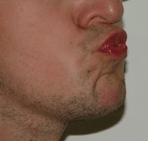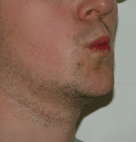Roundedness
In phonetics, vowel roundedness refers to the amount of rounding in the lips during the articulation of a vowel. It is labialization of a vowel. When a rounded vowel is pronounced, the lips form a circular opening, and unrounded vowels are pronounced with the lips relaxed. In most languages, front vowels tend to be unrounded, and back vowels tend to be rounded. However, some languages, such as French and German, distinguish rounded and unrounded front vowels of the same height, and Vietnamese distinguishes rounded and unrounded back vowels of the same height. Alekano has only unrounded vowels.[1] In the International Phonetic Alphabet vowel chart, rounded vowels are the ones that appear on the right in each pair of vowels. There are also diacritics, U+0339 ̹ COMBINING RIGHT HALF RING BELOW and U+031C ̜ COMBINING LEFT HALF RING BELOW, to indicate greater and lesser degrees of rounding, respectively.
Types of rounding
There are two types of vowel rounding: protrusion and compression.[2][3][4] In protruded rounding, the corners of the mouth are drawn together and the lips protrude like a tube, with their inner surface visible. In compressed rounding, the corners of the mouth are drawn together, but the lips are also drawn together horizontally ("compressed") and do not protrude, with only their outer surface visible. That is, in protruded vowels the inner surfaces of the lips form the opening (thus the alternate term endolabial), whereas in compressed vowels it is the margins of the lips which form the opening (thus exolabial). (Catford 1982, p. 172) observes that back and central rounded vowels, such as German /o/ and /u/, are typically protruded, whereas front rounded vowels such as German /ø/ and /y/ are typically compressed. Back or central compressed vowels and front protruded vowels are uncommon,[5] and a contrast between the two types has been found to be phonemic in only one instance.[6]
There are no dedicated IPA diacritics to represent the distinction, but the superscript IPA letter ⟨◌ᵝ⟩ can be used for compression[7] and ⟨◌ʷ⟩, ⟨◌ᶣ⟩ or ⟨◌̫⟩ for protrusion. Compressed vowels may be pronounced either with the corners of the mouth drawn in, by some definitions rounded, or with the corners spread and, by the same definitions, unrounded. The distinction may be transcribed ⟨ɨᵝ ɯᵝ⟩ and ⟨ʉᵝ uᵝ⟩.
The distinction between protruded [u] and compressed [y] holds for the semivowels [w] and [ɥ] as well as labialization. In Akan, for example, the [ɥ] is compressed, as are labio-palatalized consonants as in Twi [tɕᶣi̘] "Twi" and adwuma [adʑᶣu̘ma] "work", whereas [w] and simply labialized consonants are protruded.[8] In Japanese, the /w/ is compressed rather than protruded, paralleling the Japanese /u/. The distinction applies marginally to other consonants. In Southern Teke, the sole language reported to have a phonemic /ɱ/, the labiodental sound is "accompanied by strong protrusion of both lips",[9] whereas the [ɱ] found as an allophone of /m/ before /f, v/ in languages such as English is not protruded, as the lip contacts the teeth along its upper or outer edge. Also, in at least one account of speech acquisition, a child's pronunciation of clown involves a lateral [f] with the upper teeth contacting the upper-outer edge of the lip, but in crown, a non-lateral [f] is pronounced with the teeth contacting the inner surface of the protruded lower lip.[10]
Some vowels transcribed with rounded IPA letters may not be rounded at all. An example is /ɒ/, which in English has very little if any rounding of the lips. The "throaty" sound of English /ɒ/ is instead accomplished with sulcalization, a furrowing of the back of the tongue also found in non-rhotic /ɜː/.[11]
It is possible to mimic the acoustic effect of rounded vowels by narrowing the cheeks, so-called "cheek rounding", which is inherent in back protruded (but not front compressed) vowels. The technique is used by ventriloquists to mask the visible rounding of back vowels like [u].[12] It is not clear if it is used by languages with rounded vowels that do not use visible rounding.
| Front | Central | Back | |
|---|---|---|---|
| Semivowel | j ɥ ɥ̫ | j̈ ɥ̈ ẅ[13] | ɰ ɰᵝ/wᵝ w |
| Close | i y y̫ | ɨ ÿ ʉ[14] | ɯ ɯᵝ/uᵝ u |
| Near-close | ɪ ʏ ʏ̫ | ɪ̈ ʏ̈ ʊ̈ | ɯ̽ ɯ̽ᵝ/ʊᵝ ʊ̫ |
| Close-mid | e ø ø̫ | ɘ ø̈ ɵ | ɤ ɤᵝ/oᵝ o |
| Mid | e̞ ø̞ ø̫˕ | ɘ̞ ø̞̈/ø̽ ɵ̞ | ɤ̞ ɤ̞ᵝ/o̞ᵝ o̞ |
| Open-mid | ɛ œ œ̫ | ɜ œ̈ ɞ | ʌ ʌᵝ/ɔᵝ ɔ |
Spread and neutral
The lip position of unrounded vowels may be classified into two groups: spread and neutral. Front vowels are usually pronounced with the lips spread, and the spreading becomes more significant as the height of the vowel increases.[15] Open vowels are often neutral, i.e. neither rounded nor spread, because the open jaw allows for limited rounding or spreading of the lips.[16] This is reflected in the IPA's definition of the cardinal [a], which is unrounded yet not spread either.[17]
Roundedness and labialization
Protruded rounding is the vocalic equivalent of consonantal labialization. Thus, rounded vowels and labialized consonants affect one another by phonetic assimilation: Rounded vowels labialize consonants, and labialized consonants round vowels.
In many languages, such effects are minor phonetic detail, but in others, they become significant. For example, in Standard Chinese, the vowel /ɔ/ is pronounced [u̯ɔ] after labial consonants, an allophonic effect that is so important that it is encoded in pinyin transliteration: alveolar /tu̯ɔ/ (Pinyin duo) 'many' vs. labial /pu̯ɔ/ (Pinyin bo) 'wave'. In Vietnamese, the opposite assimilation takes place: velar codas /k/ and /ŋ/ are pronounced as labialized [kʷ] and [ŋʷ] or even labial-velar [kp] and [ŋm], after the rounded vowels /u/ and /o/.
In the Northwest Caucasian languages of the Caucasus and the Sepik languages of Papua New Guinea, historically rounded vowels have become unrounded, with the rounding being taken up by the consonant. Thus, Sepik [ku] and [ko] are phonemically /kwɨ/ and /kwə/.
In the extinct Ubykh, [ku] and [ko] were phonemically /kʷə/ and /kʷa/. A few ancient Indo-European languages like Latin had labiovelar consonants.[18]
See also
- Close back compressed vowel [ɯᵝ] or [uᵝ] (in Japanese and Swedish)
- Near-close back compressed vowel [ʊᵝ] (in Swedish)
- Close central compressed vowel [ÿ] (in Norwegian)
- Mid central compressed vowel [ø̈] (in Swedish)
- Close front compressed vowel [y] (in French, German, etc.)
- Mid front compressed vowel [ø] (in French, German, etc.)
- Close front protruded vowel [y̫] (in Swedish)
- Near-close front protruded vowel [ʏ̫] (in Swedish)
- Close-mid front protruded vowel [ø̫] (in Swedish)
- Open-mid front protruded vowel [œ̫] (in Swedish)
- Close central protruded vowel [ʉ]
- Mid central protruded vowel [ɵ]
- Close back protruded vowel [u] (common)
- Mid back protruded vowel [o] (common)
- List of phonetics topics
Notes
- ↑ Deibler (1992).
- ↑ Protrusion is also called endolabial, lip-pouting, horizontal lip-rounding, outrounding, or inner rounding (Trask 1996, p. 180).
- ↑ Compression is also called exolabial, pursed, vertical lip-rounding, inrounding, or outer rounding (Trask 1996, p. 252).
- ↑ Henry Sweet noted in 1890 that "the term 'inner rounding' derives from the use of the inner surfaces of the lips; the synonymous 'outrounding' derives from the forward projection of the lips. Both terms are justifiable, but their coexistence is likely to lead to serious confusion." (Trask 1996, p. 180)
- ↑ Sweet (1877) noted that they are less distinctive from unrounded vowels than their counterparts.
- ↑ Japanese has a back compressed [ɯᵝ] rather than protruded [u] (Okada 1999, p. 118); Swedish also has a back compressed [ɯᵝ] ⟨o⟩ as well as both front compressed [y] ⟨u⟩ and front protruded [yʷ] ⟨y⟩ (Engstrand 1999, p. 141); the front rounded vowels contrast in ruta 'window pane' and ryta 'roar' (Ladefoged & Maddieson 1996, p. 292).
- ↑ E.g. ⟨ɨᵝ⟩ in Flemming (2002, p. 83).
- ↑ Dolphyne (1988).
- ↑ Paulian (1975).
- ↑ Kelly & Local (1989), p. 41.
- ↑ Lass (1984), p. 124.
- ↑ Sweet (1877), pp. 14, 20.
- ↑ Pullum & Ladusaw (1996), p. 191.
- ↑ Both [ÿ] and [ü] have been mentioned at various times in International Phonetic Association (1999), without comment on the implied difference in rounding.
- ↑ Westerman & Ward (2015), p. 27.
- ↑ Robins (2014), p. 90.
- ↑ International Phonetic Association (1999), p. 13.
- ↑ Allen (1978).
References
- Allen, W. Sidney (1978). Vox Latina: A Guide to the Pronunciation of Classical Latin (2nd ed.). Cambridge University Press. ISBN 0-521-37936-9.
- Catford, J. C (1982). Fundamental Problems in Phonetics. Indiana University Press. ISBN 0-25320294-9.
- Deibler, Ellis (1992). "Alekano Organised Phonology Data".
- Dolphyne, Florence Abena (1988). The Akan (Twi-Fante) Language: Its Sound Systems and Tonal Structure. Ghana Universities Press. ISBN 9964-3-0159-6.
- Engstrand, Olle (1999). "Swedish". Handbook of the International Phonetic Association: A Guide to the Use of the International Phonetic Alphabet. Cambridge University Press. pp. 140–142. ISBN 0-52163751-1.
- Flemming, Edward S. (2002). Auditory Representations in Phonology. Routledge. ISBN 0-81534041-9.
- International Phonetic Association (1999). Handbook of the International Phonetic Association: A Guide to the Use of the International Phonetic Alphabet. Cambridge University Press. ISBN 0-52163751-1.
- Kelly, John; Local, John (1989). Doing Phonology: Observing, Recording, Interpreting. Manchester University Press. ISBN 0-7190-2894-9.
- Ladefoged, Peter; Maddieson, Ian (1996). The Sounds of the World's Languages. Oxford: Blackwell. ISBN 0-631-19814-8.
- Lass, Roger (1984). Phonology: An Introduction to Basic Concepts. Cambridge University Press. ISBN 0-521-28183-0.
- Okada, Hideo (1999). "Japanese". Handbook of the International Phonetic Association: A Guide to the Use of the International Phonetic Alphabet. Cambridge University Press. pp. 117–119. ISBN 0-52163751-1.
- Paulian, Christiane (1975). "Le Kukuya, langue teke du Congo: phonologie – classes nominales". Bibliothèque de la SELAF. 49–50.
- Pullum, Geoffrey K.; Ladusaw, William A. (1996). Phonetic Symbol Guide (2nd ed.). University of Chicago Press. ISBN 0-226-68536-5.
- Robins, R. H. (2014). General Linguistics (4th ed.). Routledge. ISBN 978-0-582-29144-7.
- Sweet, Henry (1877). A Handbook of Phonetics. Clarendon Press.
- Trask, R. L. (1996). A Dictionary of Phonetics and Phonology. Routledge. ISBN 0-415-11260-5.
- Westerman, D.; Ward, Ida C. (2015) [1933]. Practical Phonetics for Students of African Languages. Routledge. ISBN 978-1-138-92604-2.
External links







